Civil Rights / Cold War
Winds of Change
The National Organization for the Advancement of Colored People (NAACP) was organized in 1909 to protest and fight against racial segregation and violence. In the 1930s the group began a decades-long legal assault over separate-but-equal schools.
Their argument was that separate-but-equal education was not equal because whites still had many advantages blacks did not have. For example, black schools often received old, out-of-date textbooks while white schools got new ones. Black students couldn't always attend the school closest to their homes, they had to go to black-only schools.
In 1950, Knoxville-born NAACP lawyer Avon Williams filed a suit challenging segregation in Anderson County. He later filed a suit against the University of Tennessee in 1951. In response, state leaders upgraded the all-black Tennessee A & I (now Tennessee State University) to a state university to avoid similar suits.
In 1953, Nashville's Scarritt College and Vanderbilt University voluntarily admitted black divinity students, a decision that foreshadowed Nashville's role in the movement.
Meanwhile, the Memphis NAACP chapter, led by Joseph E. Walker, worked to register more black voters, and Walker almost won a city council seat in 1951.
Meanwhile, the Memphis NAACP chapter, led by Joseph E. Walker, worked to register more black voters, and Walker almost won a city council seat in 1951.
Segregation was finally declared illegal in the Brown v. Board of Education decision by the U.S. Supreme Court in 1954, but President Dwight Eisenhower advised "extreme restraint," favoring a gradual approach to desegregation. Since there was no time limit, many African Americans decided it would take direct action to force states to integrate.
In defiance to the Supreme Court decision, some southern congressmen issued what they called the Southern Manifesto proclaiming that southern states would resist desegregation at all costs. All southern senators signed the manifesto except for Tennessee senators Estes Kefauver and Albert Gore Sr. (Senator Lyndon Johnson from Texas didn’t sign because he said he was the majority leader.) In the House of Representatives, many more congressmen refused to sign including five of Tennessee’s nine representatives (Howard Baker, Sr., Ross Bass, Joe Evins, Percy Priest, and Carroll Reece).
Governor Frank Clement did not oppose Brown but declared that local school boards should make their own decisions about integration. Further efforts were needed to force Tennessee to comply with the new law.
To learn more about separate-but-equal legal arguments, click here.
Picture Credits:
- A photograph of the LeMoyne College NAACP membership in 1950. LeMoyne is located in Memphis. Courtesy of LeMoyne Owen College Special Collections
- A black man drinks water from a container labeled "Colored" in Oklahoma City in1939. Notice the signs indicating that both white and colored women and white and colored men could use the same restroom. However, there may have been designated stalls once inside. Photo by Russell Lee, Farm Security Administration transferred to the Library of Congress, LC-USZ62-80126
- Photograph of Zilphia Horton, wife of Highlander founder Myles Horton, leading workshop participants in singing, probably in the early 1950s. Highlander Research and Education Center Records. Wisconsin Historical Society
- Photograph of crowds of whites outside Clinton High School in 1956 when it became the first public school in Tennessee to be integrated. Eventually Governor Frank Clement had to call in the National Guard to quell unrest and violence. Photo by Robert W. Kelley//Time Life Pictures/Getty Images. This image may not be reproduced without permission from Getty Images.
- Photograph of attorneys Avon Williams and Z. Alexander Looby in 1955. The men served as the attorneys for the plaintiffs in the Nashville desegregation lawsuit. Courtesy of The Tennessean
- Father Matthew Jones of St. Luke's Episcopal Church participated in the Civil Rights movement in Knoxville. Here he is marching alone carrying a sign that proclaims "We are all Brothers in Christ." The photograph is dated June 1960. Provided by the Beck Cultural Center, photograph by the Knoxville News Sentinel.
- A photograph taken at the Memphis Greyhound bus station of crowds waiting to get on a bus in September 1943. Notice the overhead sign, "White Waiting Room" meaning that African Americans could not wait for their bus in that room. Photograph by Esther Bubley, Office of War Information Collection, Library of Congress, LC-USW3-37973-E
Civil Rights / Cold War >> Civil Rights Movement >> Winds of Change >>
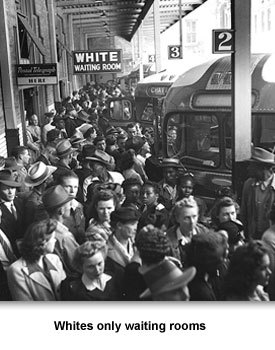
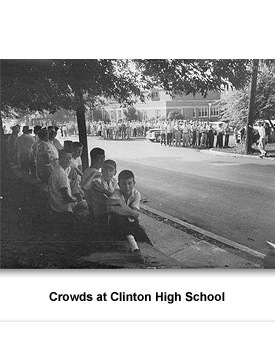
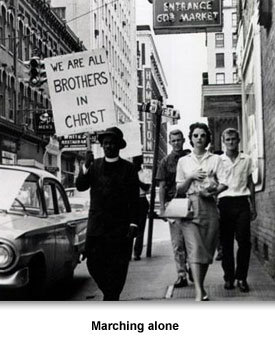
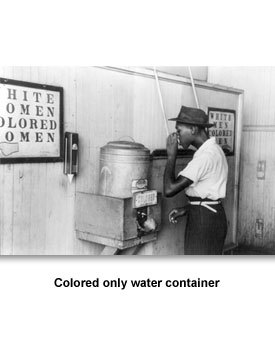
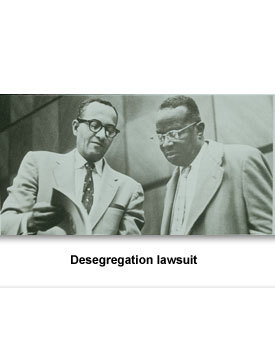
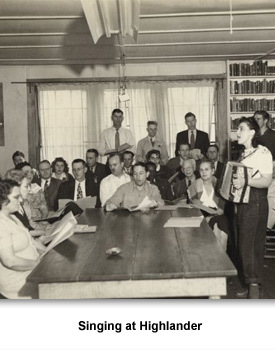
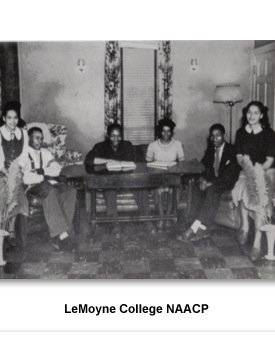
 Sponsored by: National Endowment for the Humanities
Sponsored by: National Endowment for the Humanities